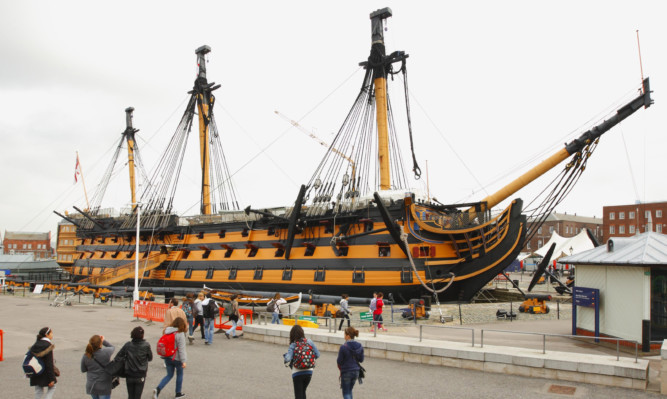Nelson’s flagship HMS Victory is to undergo renovations using newly felled oak timber – a return to the original hardwood used to build the ship 250 years ago.
Three Scottish estates have donated 10 oak trees and 11 elm trees towards the 15-year conservation project on the world’s oldest commissioned warship, which is docked at Portsmouth Historic Dockyard, Hampshire.
HMS Victory, which carried Nelson for his greatest and final battle at Trafalgar, was built from more than 5,500 oak trees and inspired the Royal Navy’s anthem march Hearts of Oak.
Now the Aberdeenshire estates of Dunecht, Haddo and MacRobert Trust have donated timber to continue the tradition as Victory, which was launched in 1767, enters its 250th year.
Charles Pearson, of the Dunecht Estate, has donated 10 oaks and four elms, while Lord Aberdeen of the Haddo Estate has donated five elms and Rear Admiral Christopher Hockley, of the MacRobert Trust Estate, has donated two elms.
Andrew Baines, head of historic ships at the National Museum of the Royal Navy (NMRN), explained that recent research on HMS Victory has shown that oak is the best timber to use for future conservation.
He said: “Currently the ship comprises a variety of hardwoods from years of maintenance. The return to oak is much welcomed. It demonstrates the serious archaeological research we are undertaking about the ship’s composition, from timber to paint analysis, and our commitment to ensure she remains sustainable for centuries to come.
“Interestingly, we understand that some 30% of the fleet at the Battle of Trafalgar hailed from Scotland, so it feels entirely appropriate that timber from these estates should be playing such a big part in her future security.”
The elm is being used for the ship’s structure below the waterline where it will be used for the keel, which is one of the oldest surviving parts of the ship and remains exposed in the dry dock.
Mr Baines said: “The quantity of elm donated by all three estates will serve as an important resource for this area in the future. Those elms which may not be suited to the particular size and shape of the keel can be made into new gun-carriages.”
Felling of the trees has been delayed by the recent poor weather and flooding but once felled the timber will be transported to the Whitney sawmill in Hereford where it will be inspected and sawed to specific dimensions appropriate for use onboard the ship.
The oak is likely to become planking and the elm is to remain in large blocks needed for the keel.
An NMRN spokeswoman said: “The timber will then be transferred to Portsmouth where it will be seasoned, so it can be dry and strong when used. This process could take as long as four years. The longer the oak is seasoned, the stronger it becomes. The oak planking will therefore go into a dry storage facility, a very rare Grade 1 listed rope walk once used to make the rope for ships like HMS Victory.”
